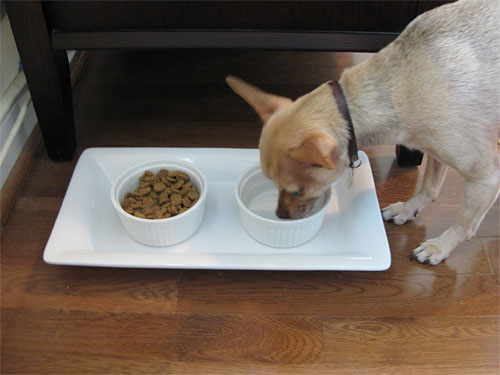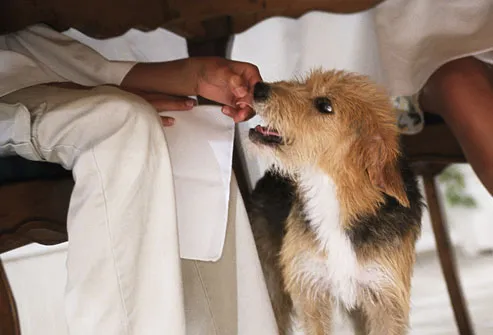
"Human, edible foods can be very healthy for your pets. Throw away the concept of “cat” food and “dog” food, and just think “food” -- food that grows in the ground or comes from animal products.
A whole generation of pet owners is afraid to feed anything but over processed rendered food to their pets. But there’s no way you can create abundant health in an animal by providing only the minimum nutrients it needs for survival. Dogs and cats have a living food requirement, just like you do.
The food you feed your pet should be biologically suited to meet your dog’s or cat’s needs. Dog and cat chow may be nutritionally “complete,” but it is akin to your drinking a meal replacement shake three times a day for the rest of your life … or giving them to your kids in lieu of fresh foods.
Your pets need living foods on a consistent basis to achieve optimal health.
So, yes, you can and should offer your pets some of the very same foods that you enjoy. And since those foods are at a much higher grade nutritionally than typical dog or cat foods, they may be the healthiest foods your pets have ever consumed.
As you know, I recommend you feed your dogs and cats an all raw, nutritionally balanced living food diet. In my opinion, the only viable excuse to not to feed your pets a species appropriate diet is cost. Feeding raw food cost more than dry food. However, raw fed animals have fewer health problems, which mean lower vet bills over a lifetime. If you cannot afford to feed your pet an all raw diet, don’t deny your pet’s access to living foods throughout the day, in the form of treats.
If you are unable or unwilling to feed your pet a species-appropriate, nutritionally balanced, raw food diet, then I strongly recommend you compromise with the next best choice: USDA-approved canned foods (and supplement with raw)
Veterinarians state that processed pet food (kibbled and canned food) is the number one cause of illness and premature death in modern dogs and cats.
My last choice would be a dry food (kibble), made from human-grade ingredients with little to no grains, and LOTS OF WATER.
Remember, treats (even really healthy treats) should not constitute more than 15 percent of your pet’s daily food intake.
Berries are one of the best treats you can offer. Bite size and packed with antioxidants. Many cats enjoy zucchini and cantaloupe. My favorite training treats for dogs include peas, raw nuts (remember, the only nuts you should never feed your pets are macadamia nuts).
A salad without dressing, but with plenty of dark green leafy vegetables, is also good for your cats -- your pets are chewing on your houseplants for a reason, after all.
Avoid giving your carnivorous companions biologically inappropriate foods, including grains, such as oats, soy, millet, , wheat, or rice. Dogs and cats do not have a carbohydrate requirement and feeding your pets these pro-inflammatory foods creates unnecessary metabolic roadblocks to health.
Furthermore, there are certainly some foods that are toxic to feed to dogs and cats such as grapes, raisins, macadamia nuts and onions. Never feed your pets these foods. "
Watch the video and read more at:
http://articles.mercola.com/sites/healthypets/archive/2009/10/10/Can-Human-Food-Be-Beneficial-for-Your-Pet.aspx
_________________
 If you don’t want your dog to beg at the table, don’t give her tidbits from your plate. If she sometimes scores a delicious morsel when she barks, whines and stares at you while you eat, she’ll diligently try those tactics whenever you sit down for a meal.
If you don’t want your dog to beg at the table, don’t give her tidbits from your plate. If she sometimes scores a delicious morsel when she barks, whines and stares at you while you eat, she’ll diligently try those tactics whenever you sit down for a meal. Remember – A dog that begs at the table may well be trying to move up in rank, since the top dog eats first and the lowest member eats last.
The best way to feed people food is at a designated feeding time in your pet's own dish. If you do this consistently and avoid feeding directly from your plate -- your dog shouldn't bother you at dinner time for anything more than a pat on the head.
Do not feed 'cold cuts', or most hot dogs. They are high in salt and nitrates. Can lead to kidney and digestive problems. ( Same applies to people, look for nitrate free hotdogs.)
"Dangerous & Unhealthy Commercial Dog food treats and foods Rawhides and dog treats- HOOVES and OTHER TREATS: are generally NOT recommended.
Most rawhides have chemical that cause cancer. But if you do still want to use them from time to time as a treat it is important that if you do give them that they are of the highest grade and US manufactured.
Therefore make sure you buy ones made in the USA and are UNBLEACHED. Do not buy the white ones as they are full of chemicals. Good quality rawhide should only get gooey and gum up when chewed, never chip off. If they chip -the chips can get lodged in the little dip in their esophagus and they can choke on that.
As many as 40% of all dogs are allergic to cow skin rawhide chews.
NEVER give COW HOOVES! They splinter and sharp pieces have killed many dogs. Better alternatives are pig ears, nylabones, and American made bully sticks - however ALWAYS be with your pet when they are eating these as there is always a danger of a piece breaking off and splitting. Nylarbones are not detectable on an x-ray.
Also when giving Pigs/Cows ears it's best to give basted or natural - NOT SMOKED. That puts a carcinogenic coating on it. Unbleach/natural lambs ears are another better choice. Always supervise your pet when chewing these types of things.
Greenies - are the latest popular treat to become deadly. It is found that they can be slippery and if a piece slides down the throat the dog can die. Also some animals are having problems digesting. For now we recommend you avoid them till further changes are made.
Also supervise any chew treats! Also read labels. Many commercial dog treats contain: BHA, BHT, ethoxyquin & propylene glycol– and corn syrups/sugars that cause cancer. Do NOT use treats with ANY OF THESE THINGS! "
___________________

Stick Blender.
The other day I had a big stalk of celery that needed to be used up. I wasn't going to be making any stews or anything like that, so I thought I would make some cream of celery soup.
I cooked it for a few minutes in my little WeeOne electric pressure cooker, and ran my stick blender in the pot. I had done this before with my cheapie from Dollar General, but this time I used my more expensive immersion blender.

BUT, I hadn't noticed a big difference in the placement of the blade, and I got celery strings caught up under it.
I thought the blade would pull off, but we all tried, and it didn't.
So I had to resort to medical tools to get the strings out. Hemostats and a dental probe!
Next time I will use the cheapie for anything stringy, it didn't bother it at all.
I love my stick blenders, and wouldn't be without one.
I could have "strung" each piece of celery, but it is easier for me to run the cooked celery through a strainer, and discard what doesn't go through. The birds like it.
Just telling you this, so you will know what to look for when buying one.
This morning the low was 25 deg., and I hadn't covered the aloe vera trough out back, but thankfully it seems to be alright.
At 11.00 AM it is 56 deg., so it quickly warmed up to a sunny, warm day.
















3 comments:
Good information..thanks for sharing. I've been thinking about changing the kitties diet, but don't know exactly what to feed them.
I've had a similar problem when blending celery or greens. For the clery, next time snap the stalks in half and pull the strings off. Then, pressure cook, blend and enjoy!
L
hip pressure cooking
making pressure cookers hip again, one recipe at a time!
Thank you for your comments Karen and Al, and elle pee. It is great to hear from 'lurking' readers, as I like to know who is reading my little two-cents.
You each have at least two blogs that are very interesting, and I shall keep an eye on them. Thank you.
Happy Trails, Penny, TX
Post a Comment